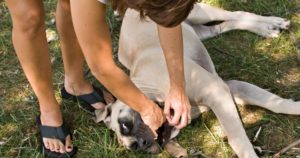The first image most people have of dogs in cars involve their K9 happily staring out the open window, tongue out, enjoying the scenery and observing his or her surroundings.
Unless, of course, you’re the owner with the dog suffering from motion sickness.
Car rides are a little less fun for Fido when it leaves them feeling nauseous and, in some cases, vomiting.
I just happened to have one of those dogs that found traveling stressful and suffered from motion sickness. Thankfully, most pets don’t need to ride in a car often, but there are those trips to the vet or kennel.
We know that Dramamine can help humans who suffer from motion sickness, but is it safe for our dogs?
Let’s find out!
What Causes Motion Sickness in Dogs?
Motion sickness in dogs can occur for a couple of reasons. It’s more common in puppies perhaps because the parts associated with balance in their inner ear haven’t completely developed yet. Eventually, younger dogs grow out of motion sickness around the time they’re 1 year old.
Puppies may also become anxious because their first experience riding in a car was frightening or stressful. Therefore, they associate all car rides with that first traumatic experience.
Adult dogs get motion sickness due to the motion of travel, much like people, or because of anxiety. Often dogs get anxious during car rides because they are overwhelmed with all of the unusual stimuli that they aren’t used to seeing or the lack of conditioning.
If your pooch only travels to the vet a few times a year, they may negatively associate car rides with their stressful experiences there.
There could be other medical problems such as vestibular disease or ear infections that make your dog prone to nausea. The vestibular disease involves the vestibular apparatus located inside the inner ear. Your dog may be on other medications with side effects that cause diarrhea, nausea, or vomiting.
Symptoms of Motion Sickness
So, now your asking, “but how do I know if my dog is getting sick in the car?” Since animals can’t tell us when they’re sick; they give off several visual cues that include:
- Pacing
- Drooling excessively
- Whining
- Inactivity or lethargy
- Diarrhea
- Vomiting
- Licking lips excessively
- Shaking or trembling
- Yawning
- Listlessness
- Fear of cars
- Rapid breathing
If you think that your poor pup is about to get sick, stop the car and take them for a walk. A short walk may help alleviate his stress.
Preventing Motions Sickness with Dramamine
Dramamine, otherwise known by its generic name Dimenhydrinate, is an antiemetic and an antihistamine that humans use for motion sickness. It reduces nausea and vomiting symptoms of car sickness. Dramamine is a combination of 8-chlorotheophylline, a mild stimulant, and diphenhydramine which is the primary ingredient in Benadryl.
Dimenhydrinate prevents stimulation of the vestibular system located in the inner ear. The vestibular system is the system of the brain the detects motion. Essentially, this medicine blocks the neurotransmitters that transmit messages from the vestibular apparatus to the area of the brain that coordinates reflex actions such as swallowing and vomiting.
When humans or dogs receive too much stimulation to the vestibular system, they develop symptoms of stumbling, dizziness, vomiting, and nausea.
Is Dramamine Appropriate for Your Dog?
Currently, Dramamine isn’t FDA approved for cats and dogs, but veterinarians prescribe it frequently because it has few side effects. Vets can legally prescribe it as an extra-label drug as long as your vet is sure that it’s a suitable treatment. It’s also sometimes prescribed for animals diagnosed with anxiety and utilized as a sedative.
Several studies illustrate that many cases of motion sickness in dogs are not related to motion but rather induced by stress. Since traveling removes your pet from the comfortable environment that they are familiar with, you may want to speak with your vet about using Dramamine for your dog.
Make sure that you provide your dog’s care provider with his complete medical history including any other medicine that he may be taking. Discuss the symptoms that you’ve observed as well as any questions you have about your dog’s medical condition. Your veterinarian can determine if this medication is an appropriate treatment or if a more complicated medical problem is the cause of their illness.
If your dog has any of the following medical problems, it is critical that you consult with your veterinarian:
- Urinary obstruction
- Allergies or hypersensitivity to antihistamines or Dramamine
- Intestinal or stomach obstruction
- Bladder neck obstruction
- Seizures
- COPD
- Enlarged prostate or prostate disease
- Gastric outflow obstruction
- Nursing or pregnant
- Glaucoma
- Lung disease
- Heart disease
- Liver disease
- Kidney disease
- Hyperthyroidism
- High blood pressure
Beware, Dramamine may interact with other drugs such as:
- Warfarin
- Central nervous system depressants
- Sedatives
- Anticholinergic drugs
- Tranquilizers
- Heparin
- May decrease anticoagulant effects
- May increase effects of Epinephrine
The Right Dosage of Dramamine
Appropriate dosing for your pet is critical. Dosing depends on your dog’s breed, pre-existing medical conditions, size/weight, current medications, and other health issues. Often, medium to large dogs can take 25-50 mg of the medicine at least ½ to 1 hour before traveling.
Leave at least 8 hours between doses. Small dogs can have 12.5 mg. Every dog reacts to medication differently and each one will tolerate Dramamine differently.
These doses are common but consult your vet before giving these amounts to your pet. Remember, always ask your vet before giving your dog any medication.
Dramamine for Kids, chewable, or standard tablets should be okay for your pet at the right dosage. The “All Day/Less Drowsy” version of the medication should also be safe. It contains meclizine for a less drowsy and sedative effect. The “Non-Drowsy Naturals” form of the drug is not safe for dogs since it contains large amounts of ginger. Ginger is okay for dogs in small quantities but not in high concentrations.
Side Effects of Dramamine
Your dog may experience some common side effects when taking Dramamine and they include:
- Lethargy
- Sedation
- Urine retention
- Dry mouth
More severe side effects may include:
- Weight loss
- Vomiting
- Diarrhea
- Reduced appetite
- Rapid heartbeat
The severe side effects are rare so monitor your dog to see if any of these symptoms appear. If they do, or you feel uncomfortable about the dosing, stop the medication and consult your veterinarian. You may even want to discuss alternative treatments that may suit your pet better.
Dramamine and Overdose Risks
Please be careful when you give your dog any medication, even if it’s prescribed. Always make sure to medicate your pet with the appropriate dose. Watch for these symptoms and signs of an overdose in your dog:
- Urinary retention
- Coma
- Seizures
- Extreme sedation
- Rapid heartbeat
- Hallucinations
- Hyperventilation
If you think that your dog has overdosed on Dramamine, contact your vet, emergency veterinarian clinic, the Animal Poison Control Center Helpline (1-888-426-4435), or the ASPCA Pet Poison Help Line (1-800-213-6680). Usually, you’ll be advised to induce vomiting in your dog or to take them to the closest emergency vet clinic.
Administering Dramamine
Here are some general tips for administering Dramamine to your dog. Of course, follow your veterinarian’s instructions above all else. The best way to give your dog his medicine is to crush it up and mix it with his food or favorite treat.
Pill poppers are also available at pet stores or online. A pill popper is a device shaped like a tube that holds the pill or tablet in one end. Put the device into your dog’s mouth by placing the end with the pill close to the back of his throat, then release the pill. The pill popper prevents your dog from spitting the pill out and works well for medicines that are more effective if left intact.
Timing of Doses
Dosage timing is crucial to determine the effectiveness of Dramamine for your pet’s motion sickness. The times mentioned above are based on common dosing but consult your vet for the proper timeframes to use for dosing your dog. ½ hour to 1 hour before traveling is a good rule of thumb. Don’t miss any doses that your vet has recommended.
Administration Length
How long you continue to administer Dramamine to your pet is up to your vet. Your veterinarian uses several factors to determine administration length; how your pet responds to the drug, what medical condition your vet is treating him for, and if your dog has developed any negative reactions to Dramamine. Continue giving your dog the full prescription of Dramamine unless your vet advises otherwise. You should keep administering the medicine even if your pet shows signs that he’s improving.
Continue to Monitor the Health of Your Dog
Since Dramamine was formulated with humans in mind, it’s vital to continuously monitor your dog’s response to treatment. By remaining aware of his condition and the signs of adverse side effects or reactions you can reduce the possibility of more medical problems. If your pet vomits after ingesting Dramamine, it may indicate that he can’t tolerate the medicine.
Natural Motion Sickness Treatments
There are also natural treatments available that work in conjunction with Dramamine or as an alternative.
Short Trips and Conditioning
To relieve some of your dog’s travel anxiety, try taking short trips to places such as a close park where he can get out and walk. Short breaks help alleviate some of your pet’s anxiety. You can also try rolling the windows down when you’re in the car. Praise your pet and reward their good behavior for conditioning them to ride in a vehicle with less anxiety. Once they no longer associate traveling negatively, the symptoms of motion sickness may subside.
You may start with simply placing your dog in the car and starting the engine without moving. For the next trip, start the car and back out of the driveway and then gradually work up the trip time from there. This process may take several weeks, but it may save your pet a lot of stress and trauma.
Here are some additional tips for traveling:
- Don’t feed your pet for 12 hours before traveling. Withholding food reduces nausea and the need for frequent breaks during long trips by car, train, or plane. However, if you’re in a car and it’s feasible, taking breaks is good for your pet.
- Give your pet special toys that are only for traveling. Special travel toys help your pet associate car rides with fun.
- Use a safety harness designed for dogs or a carrier for safety. Anxious dogs panic and can cause accidents or hurt themselves. Dogs often consider carriers a safe place.
- Keep the vehicle quiet and cool for your dog. Play soothing music and make sure that the temperature doesn’t get too hot because that will only exacerbate nausea and anxiousness.
- Include something from home to make your pet feel comfortable. Put a blanket with your dog’s scent or yours in the car. You can even bring one of your t-shirts.
Additional Medical Remedies
Pheromones such as Adaptil or aromatherapy such as lavender can calm your dog. These scents are naturally soothing. Some herbs have a calming effect such as kava, Bach flower, valerian, skullcap, and passionflower just to name a few. Peppermint, chamomile, and small amounts of ginger also help calm your pet.
Additionally, there are other anti-nausea medicines such as Cerenia that are available by prescription. For pets with extreme anxiety, your vet may prescribe Xanax or other prescription medicines for anxiety. You should start any prescription medicines a few days to several weeks before you travel for the maximum effect.
Today, there are even vet-recommended hemp and CBD products that are safe and effective at relieving motion sickness symptoms and anxiety in pets. Canna-Pet® has all organic, high-quality hemp pet products that help with gastrointestinal disorders, nausea, and vomiting. Most well-known pet insurance companies cover these products. There are also CBD treats and oils for animals that naturally relieve the symptoms of motion sickness.
We know that your pet’s health and safety is of the utmost importance. Undue stress and anxiety can be traumatic for your dog. Dramamine is an excellent choice to reduce or eliminate car sickness symptoms and make traveling much easier on your pet.
Always remember to contact your vet before giving any herbal or prescription medicine to your dog. A veterinarian can give you the best advice on how to remedy motion sickness.






